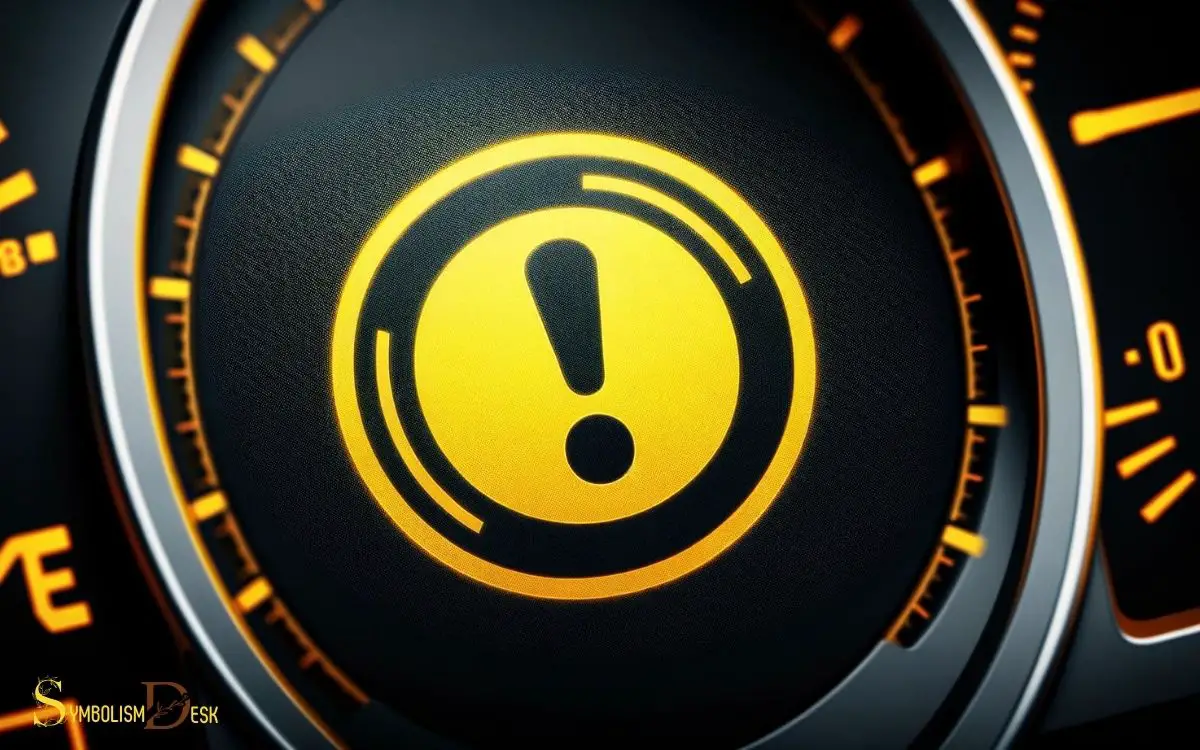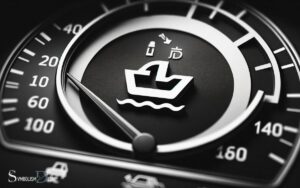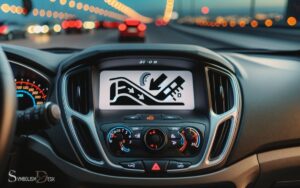Yellow Light Symbols Circle With Exclamation Mark Inside Car
When you encounter a yellow light symbol in the shape of a circle with an exclamation mark inside on your car’s dashboard, it typically signals a Tire Pressure Warning Light.
This alert means that one or more of your tires may be significantly underinflated, which could lead to unsafe driving conditions or tire damage.
It is important to stop driving at the earliest safe opportunity and check your tire pressures, adjusting them according to the manufacturer’s recommended settings.
The Tire Pressure Warning Light is an important feature found in modern vehicles, designed to inform the driver about tire pressure issues.
With tire pressure monitoring systems (TPMS) installed in cars, this dashboard symbol is part of the system’s function to monitor tire pressure in real time. When the pressure drops below a certain threshold, the system triggers the light to warn the driver.
Some common reasons for the light to activate include:
Properly inflated tires are crucial for optimal vehicle handling, fuel efficiency, and the prevention of tire wear. Therefore, maintaining the recommended tire pressure is essential for your safety and your vehicle’s performance.
For your safety and to maintain vehicle performance, always monitor your tire pressure and address any warnings such as the yellow circle with an exclamation mark promptly.

Key Takeaway
Understanding the Yellow Light Symbol
The yellow light symbol with a circle and exclamation mark inside indicates a potential issue with the vehicle that requires attention. When this warning light appears on the dashboard, it is essential for the driver to address the underlying problem promptly.
The specific nature of the issue can vary, ranging from low tire pressure to a malfunction in the engine or braking system.
It is crucial for drivers to consult the vehicle’s manual to identify the precise cause of the warning light. Ignoring this signal could lead to further damage or safety hazards.
Therefore, it is advisable to seek professional assistance to diagnose and resolve the issue. Understanding the significance of this warning light can help drivers take proactive measures to maintain the car’s performance and safety.
Common Causes of the Yellow Light
The yellow light on the dashboard can indicate a range of issues that need attention. Common causes of the yellow light include low tire pressure, engine or oil issues, and brake system problems.
Understanding these potential causes can help drivers address the problem promptly and ensure the safety and performance of their vehicle.
Low Tire Pressure
When the yellow light symbol with a circle and exclamation mark inside appears in a car, it often indicates low tire pressure, which can be caused by various factors.
Common causes of low tire pressure include:
- Temperature changes: Fluctuations in temperature can cause tire pressure to decrease, especially during the transition from warmer to colder weather.
- Punctures or leaks: Sharp objects on the road or damaged tire valve stems can lead to slow leaks, causing gradual loss of tire pressure.
- Aging tires: As tires age, the rubber can become porous, leading to slow air leaks and decreased tire pressure over time.
- Improper inflation: Failing to maintain the recommended tire pressure levels can result in underinflated tires, triggering the yellow light symbol in the car.
Engine or Oil Issues
One potential cause of the yellow light symbol with a circle and exclamation mark inside a car is low engine oil pressure, often attributed to insufficient oil levels or oil pump malfunctions.
When this light comes on, it indicates potential issues with the engine or oil system that require immediate attention.
The following table summarizes common causes of the yellow light and their implications:
| Issue | Implication |
|---|---|
| Low engine oil levels | Increased friction and potential engine damage |
| Oil pump malfunction | Inadequate oil circulation leading to engine damage |
| Oil filter blockage | Impaired oil flow and potential engine overheating |
Understanding these common causes can help drivers promptly address engine or oil-related issues, preventing potential damage and ensuring the vehicle’s optimal performance.
Brake System Problems
Potential brake system problems can trigger the yellow light symbol with a circle and exclamation mark inside a car, indicating issues that require immediate attention.
The common causes of this warning light include:
- Worn Brake Pads: Over time, brake pads wear down, leading to reduced braking performance and the potential for damage to other brake components.
- Low Brake Fluid: Insufficient brake fluid levels can indicate a leak or worn brake pads, which may compromise the vehicle’s braking capabilities.
- Brake Rotor Issues: Warped or damaged brake rotors can cause vibrations, squealing noises, or reduced braking efficiency.
- Faulty Brake System Sensors: Malfunctioning sensors can trigger the yellow light, necessitating a diagnostic check to identify and rectify the issue.
Potential Risks and Safety Concerns
Although drivers may encounter the yellow light symbol with a circle and exclamation mark inside their cars, it is essential to be aware of the potential risks and safety concerns associated with this warning indicator.
This symbol typically indicates a non-specific issue that requires attention, posing potential risks if ignored. Drivers should promptly address the underlying problem to ensure their safety and prevent further damage to the vehicle.
Here’s a breakdown of potential risks and safety concerns:
| Potential Risks | Safety Concerns |
|---|---|
| Reduced braking power | Increased stopping distance |
| Brake system failure | Limited vehicle control |
| Overheating brakes | Risk of accidents |
Understanding these risks highlights the importance of promptly addressing any issues indicated by the yellow light symbol, enhancing overall road safety.
Recommended Actions to Take
When faced with the yellow light symbol with a circle and exclamation mark inside the car, it is crucial to take recommended actions to ensure vehicle safety. This symbol, often referred to as the brake warning light, usually indicates an issue with the braking system, such as low brake fluid or a problem with the brake pads. Ignoring the symbols circle warning in car dashboards can lead to compromised safety and potential damage to the vehicle. It is important to consult the owner’s manual and address the issue promptly, either by inspecting the car yourself or seeking professional assistance.
Simple measures such as checking tire pressure and inspecting the brake system can prevent potential hazards on the road. By staying proactive and addressing these points, drivers can maintain a safe and reliable driving experience.
Check Tire Pressure
The warning light with a circle and exclamation mark indicates a need to check tire pressure.
When this light appears on the dashboard, it’s important to take the following actions:
- Pull Over Safely: If the light comes on while driving, find a safe place to pull over and inspect the tires.
- Check Tire Pressure: Use a tire pressure gauge to measure the pressure in each tire, ensuring it matches the manufacturer’s recommended pressure levels.
- Inflate or Deflate: Add air to any tires that are underinflated or release air if they are overinflated to reach the correct pressure.
- Inspect for Damage: While checking the pressure, also inspect the tires for any signs of damage or punctures that may be causing pressure loss.
Inspect Brake System
The driver’s primary course of action when the yellow light symbol with a circle and exclamation mark appears is to inspect the brake system for any signs of malfunction.
This includes checking the brake fluid level, ensuring the brake pads and rotors are in good condition, and examining the brake lines for any leaks or damage.
If any issues are noticed during the inspection, it is recommended to take the vehicle to a certified mechanic for further evaluation and potential repairs. Ignoring potential brake system malfunctions can lead to safety hazards and further damage to the vehicle.
Prompt attention to any brake system warning signs is essential to ensure the continued safe operation of the vehicle.
Diagnosing and Resolving the Issue
To diagnose and resolve the issue of a yellow light symbol with a circle and exclamation mark inside a car, start by checking the vehicle’s owner’s manual for guidance.
Once the manual has been consulted, consider the following steps:
- Check Brake Fluid Level: Insufficient brake fluid can trigger the warning light. If the level is low, adding more fluid may resolve the issue.
- Inspect Brake Pads and Rotors: Worn-out brake pads or damaged rotors could also be the cause. Visually inspect these components for wear and tear.
- Examine Brake System Sensors: Faulty sensors can trigger the warning light. Inspect the sensors for any damage or loose connections.
- Seek Professional Assistance: If the issue persists after performing these checks, it is advisable to seek the expertise of a qualified mechanic for a thorough inspection and repair.
Preventative Maintenance Tips
When maintaining a vehicle with the yellow light symbol of a circle and exclamation mark, it is essential to perform regular inspections and servicing. Preventative maintenance can help avoid potential issues associated with this warning light.
Here are some key tips for preventative maintenance:
| Maintenance Task | Frequency | Importance |
|---|---|---|
| Check tire pressure | Monthly | Ensures safety and optimal fuel efficiency |
| Inspect brake system | Every 6 months | Crucial for vehicle safety |
| Change engine oil | Every 5,000 miles | Vital for engine longevity and performance |
| Test battery | Annually | Prevents unexpected breakdowns |
Regularly attending to these maintenance tasks can help ensure the vehicle’s optimal performance and safety, and prevent potential issues indicated by the yellow light symbol.
Conclusion
So, next time you see that yellow light symbol with the exclamation mark in your car, don’t panic! Take a deep breath, and remember to stay calm and focused.
With proper maintenance and timely action, you can keep your car running smoothly and avoid any potential roadblocks. Remember, an ounce of prevention is worth a pound of cure!






